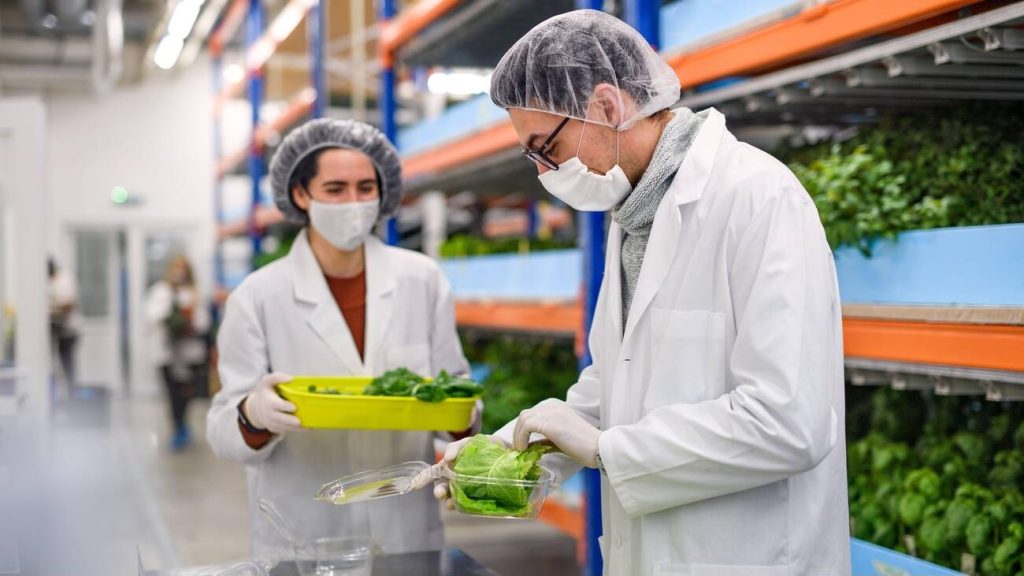Imagine a world where the food on your plate not only nourishes your body but also supports the well-being of our planet. In this sustainable food system, you have the power to make choices that benefit both yourself and future generations. From organic and locally sourced produce to sustainable seafood options and plant-based protein alternatives, there are a variety of foods that play a crucial role in creating a more sustainable future. Join us as we explore which of these foods would be part of a truly sustainable food system.
Organic and Locally Sourced Produce
If you’re looking for foods that would be part of a sustainable food system, organic and locally sourced produce would be a great choice. Organic farming benefits the environment by reducing the use of synthetic pesticides and fertilizers, promoting soil health, and preserving biodiversity. Sustainable agriculture techniques used in organic farming include crop rotation, composting, and natural pest control methods. Locally sourced produce helps reduce food miles, which refers to the distance food travels from farm to plate. By purchasing locally grown produce from farmer’s markets or community-supported agriculture (CSA) programs, you support local farmers and reduce carbon emissions associated with long-distance transportation. Additionally, choosing organic and locally sourced produce helps minimize the environmental impact of food production by supporting more sustainable farming practices and reducing reliance on fossil fuels for transportation.
Sustainable Seafood Options
Sustainable seafood options can be incorporated into a well-balanced diet. By choosing seafood that has been caught or farmed using sustainable fishing practices and aquaculture sustainability, you can support the health of our oceans and marine life. Look for seafood certification programs such as the Marine Stewardship Council (MSC) or Aquaculture Stewardship Council (ASC) labels to ensure that the fish you consume comes from sources that prioritize environmental responsibility. These certifications guarantee that overfishing solutions are being implemented, helping to protect endangered species and maintain healthy fish populations. Additionally, supporting marine conservation efforts by avoiding unsustainable fishing practices like bottom trawling or illegal fishing is crucial in preserving our oceans for future generations. Choose sustainably sourced seafood options and become an advocate for responsible fishing practices.
Plant-Based Protein Alternatives
You can explore a variety of plant-based protein alternatives to incorporate into your diet. Plant-based protein sources offer numerous health benefits and have a lower environmental impact compared to animal-based proteins. Consumer demand for plant-based products is on the rise, prompting food industry innovation in this area.
There are several plant-based protein sources you can consider adding to your meals. Legumes such as beans, lentils, and chickpeas are excellent options that provide both protein and fiber. Other plant-based protein sources include tofu, tempeh, seitan, and edamame. These alternatives not only offer essential nutrients but also contribute to reducing greenhouse gas emissions and land use associated with livestock production.
In response to the growing demand for plant-based proteins, the food industry has been developing innovative products like plant-based burgers, sausages, and dairy-free milk alternatives made from soy or nuts. These products aim to mimic the taste and texture of traditional animal-derived foods while providing a sustainable alternative.
Regenerative Agriculture Practices
To support regenerative agriculture practices, consider incorporating methods such as cover cropping and crop rotation into your farming techniques. These soil regeneration techniques are essential for maintaining the health and fertility of your land. By planting cover crops like legumes or grasses, you can protect the soil from erosion, improve its structure, and increase nutrient availability. Crop rotation helps break pest cycles and reduces the risk of disease outbreaks while promoting biodiversity preservation strategies. Additionally, implementing carbon sequestration methods through practices like no-till farming can help capture and store carbon in the soil, mitigating climate change. Water conservation practices such as drip irrigation or mulching can also play a crucial role in sustainable agriculture by minimizing water waste. Lastly, agroforestry implementation involves integrating trees into agricultural systems to provide shade, windbreaks, and additional sources of income.
Zero-Waste Food Production
Incorporating zero-waste practices into your food production can minimize resource waste and promote environmental sustainability. By implementing food waste reduction strategies, such as composting initiatives and sustainable food preservation methods, you can significantly reduce the amount of waste generated during the production process. Upcycling food waste, by finding creative ways to repurpose or reuse it, also contributes to a more sustainable system. Additionally, participating in food redistribution programs can help ensure that excess or surplus food is given to those in need instead of being thrown away. Check out the table below for some examples of these practices:
| Food Waste Reduction Strategies | Examples |
|---|---|
| Composting Initiatives | Turning organic waste into nutrient-rich compost |
| Sustainable Food Preservation Methods | Canning, pickling, fermenting |
| Upcycling Food Waste | Making vegetable stock from kitchen scraps |
| Food Redistribution Programs | Donating excess food to local charities or shelters |
Fair Trade and Ethically Sourced Ingredients
When sourcing ingredients for your food production, it’s important to consider fair trade and ethical practices. Here are four key aspects to keep in mind:
- Ethics in Sourcing: Ensure that the ingredients you use are sourced from suppliers who prioritize ethical practices. This means they treat their workers fairly, pay them livable wages, and provide safe working conditions.
- Supply Chain Transparency: Look for suppliers who have transparent supply chains. This means they can trace the journey of their ingredients from farm to table, ensuring accountability and minimizing the risk of unethical practices.
- Social Impact: Choose ingredients that have a positive social impact. This could mean supporting local farmers or communities, empowering marginalized groups, or contributing to social development projects.
- Environmental Certifications and Fair Trade Certifications: Seek out ingredients that have environmental certifications, indicating sustainable farming methods and minimal ecological impact. Additionally, look for fair trade certifications which guarantee fair prices for producers and support community development.
Seasonal and Regional Food Choices
Make mindful choices by considering the seasons and regions when selecting your ingredients. Opt for seasonal produce instead of imported ones to support a sustainable food system. By choosing locally grown fruits and vegetables, you contribute to the farm-to-table movement and show support for local farmers. Eating locally has numerous benefits, including fresher and more nutritious food, reduced carbon footprint from transportation, and stronger local economies. It also promotes biodiversity through food choices since local farmers often cultivate a wider variety of crops than large-scale industrial agriculture. By embracing seasonal and regional food choices, you not only savor the flavors of each season but also play an active role in creating a more sustainable and resilient food system for yourself and future generations.
Reduced Food Packaging and Waste
To reduce food packaging and waste, you can start by opting for bulk items and bringing your own reusable bags and containers to the grocery store. Here are four strategies to help you reduce food waste and promote sustainable packaging solutions:
- Choose products with minimal or eco-friendly packaging: Look for items that come in recyclable or compostable materials, or those that use less packaging overall.
- Practice smart meal planning: Plan your meals ahead of time to avoid overbuying ingredients that may go to waste. Freeze leftovers or repurpose them into new dishes.
- Participate in composting initiatives: Composting allows organic waste like fruit peels, vegetable scraps, and coffee grounds to be turned into nutrient-rich soil for gardening.
- Support food recovery programs: Donate excess food to local organizations that distribute it to those in need, reducing both food waste and hunger in your community.
Community Supported Agriculture (CSA) Programs
By participating in Community Supported Agriculture (CSA) programs, you can support local farmers and have access to fresh, seasonal produce. CSA membership benefits include receiving a weekly or bi-weekly share of the harvest directly from the farm. This not only ensures that you are getting the freshest produce possible but also allows you to try new and unique varieties that may not be available in supermarkets. CSA farm partnerships create a direct connection between farmers and consumers, eliminating the need for middlemen and reducing transportation costs. This has a positive impact on local economies by keeping money within the community and supporting small-scale farmers. Additionally, CSA programs promote food accessibility by offering affordable shares and providing options for low-income individuals through subsidized memberships. Lastly, CSA programs foster community engagement through events such as farm visits, volunteer opportunities, and shared meals where members can come together to celebrate local agriculture.
Indigenous Food Systems and Traditional Knowledge Integration
In the previous subtopic, you learned about Community Supported Agriculture (CSA) programs and how they contribute to a sustainable food system. Now, let’s explore another important aspect of a sustainable food system: Indigenous Food Systems and Traditional Knowledge Integration.
- Indigenous Food Preservation: Indigenous communities have unique methods of preserving their traditional foods, such as smoking, drying, fermenting, and pickling. These preservation techniques ensure the availability of nutritious food year-round.
- Traditional Farming Techniques: Indigenous communities practice sustainable farming techniques that prioritize soil health, biodiversity, and water conservation. They utilize intercropping, agroforestry, and crop rotation to maintain ecological balance.
- Cultural Food Heritage: Indigenous food systems are deeply rooted in cultural traditions and customs. They celebrate diversity through the cultivation and consumption of native crops that have been passed down through generations.
- Sustainable Hunting Practices and Land Stewardship: Indigenous communities have a deep connection with the land and practice sustainable hunting practices that respect wildlife populations’ sustainability. They also engage in land stewardship by protecting biodiversity hotspots and conserving natural resources for future generations.

